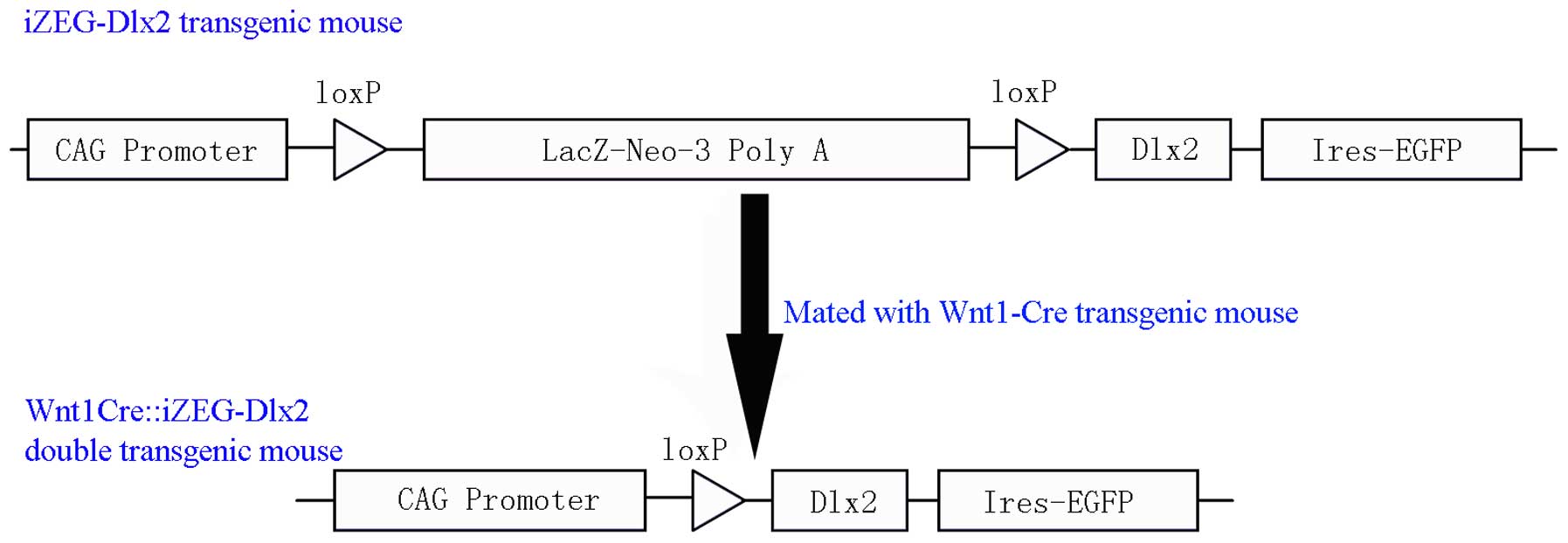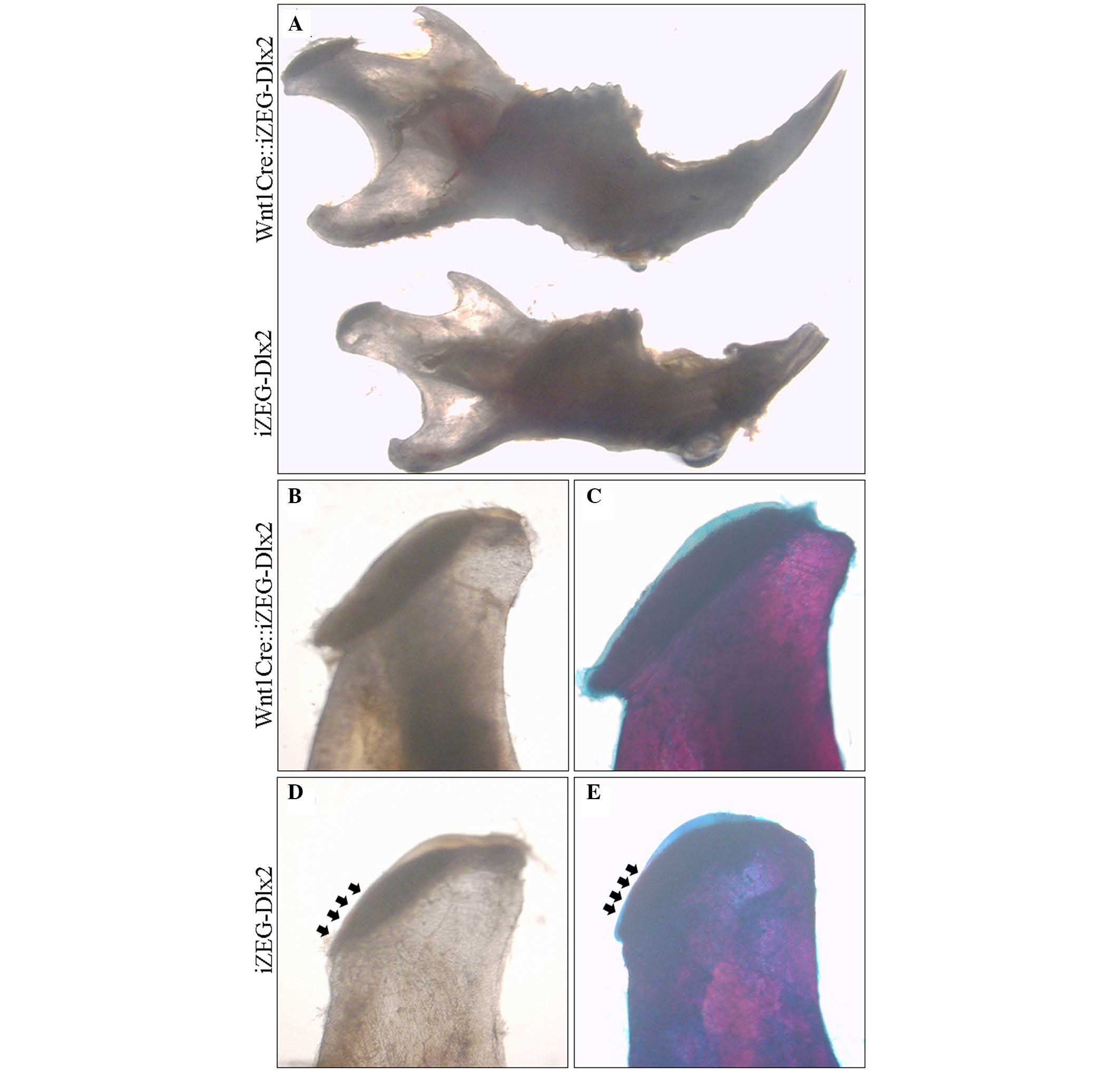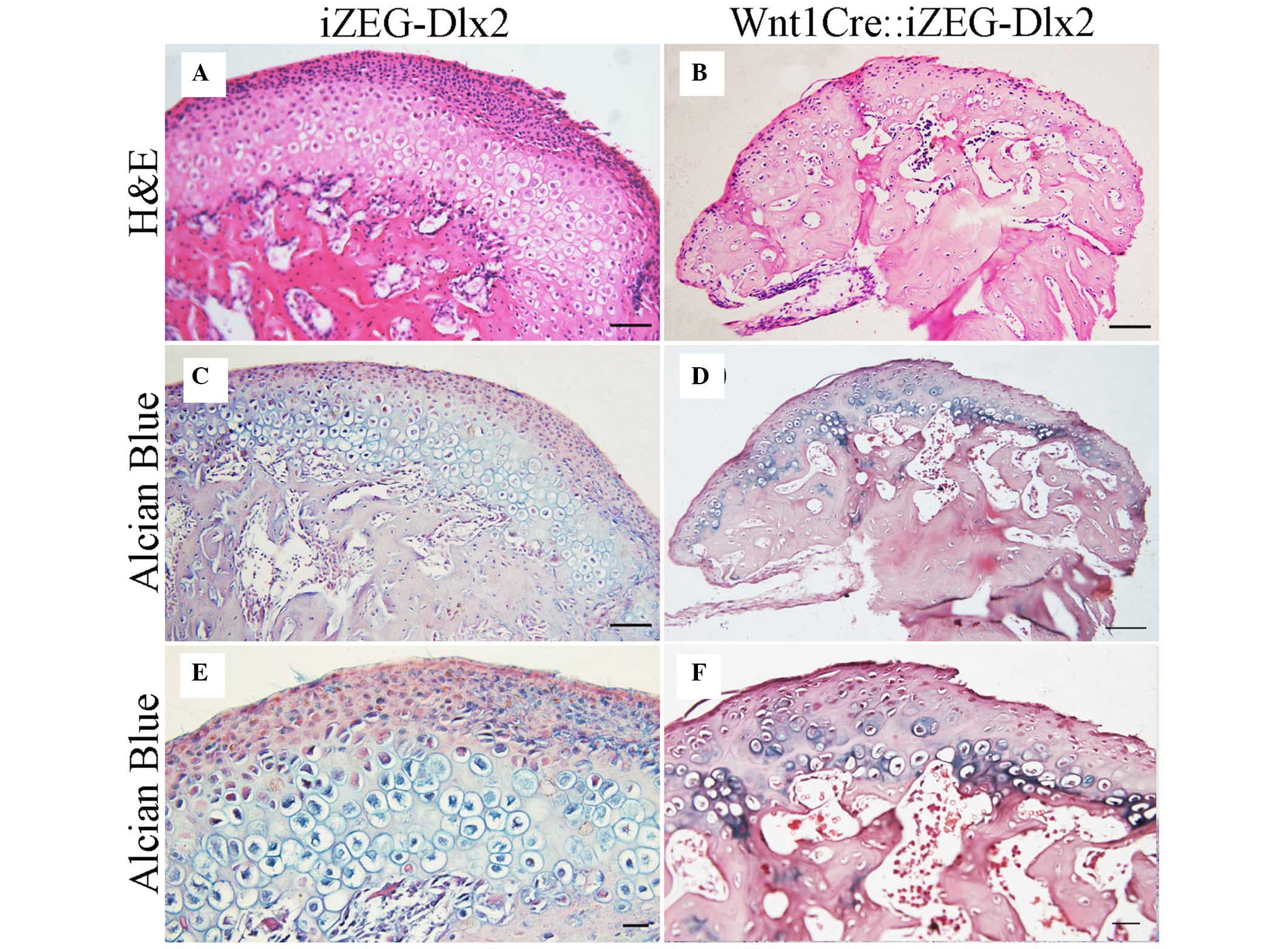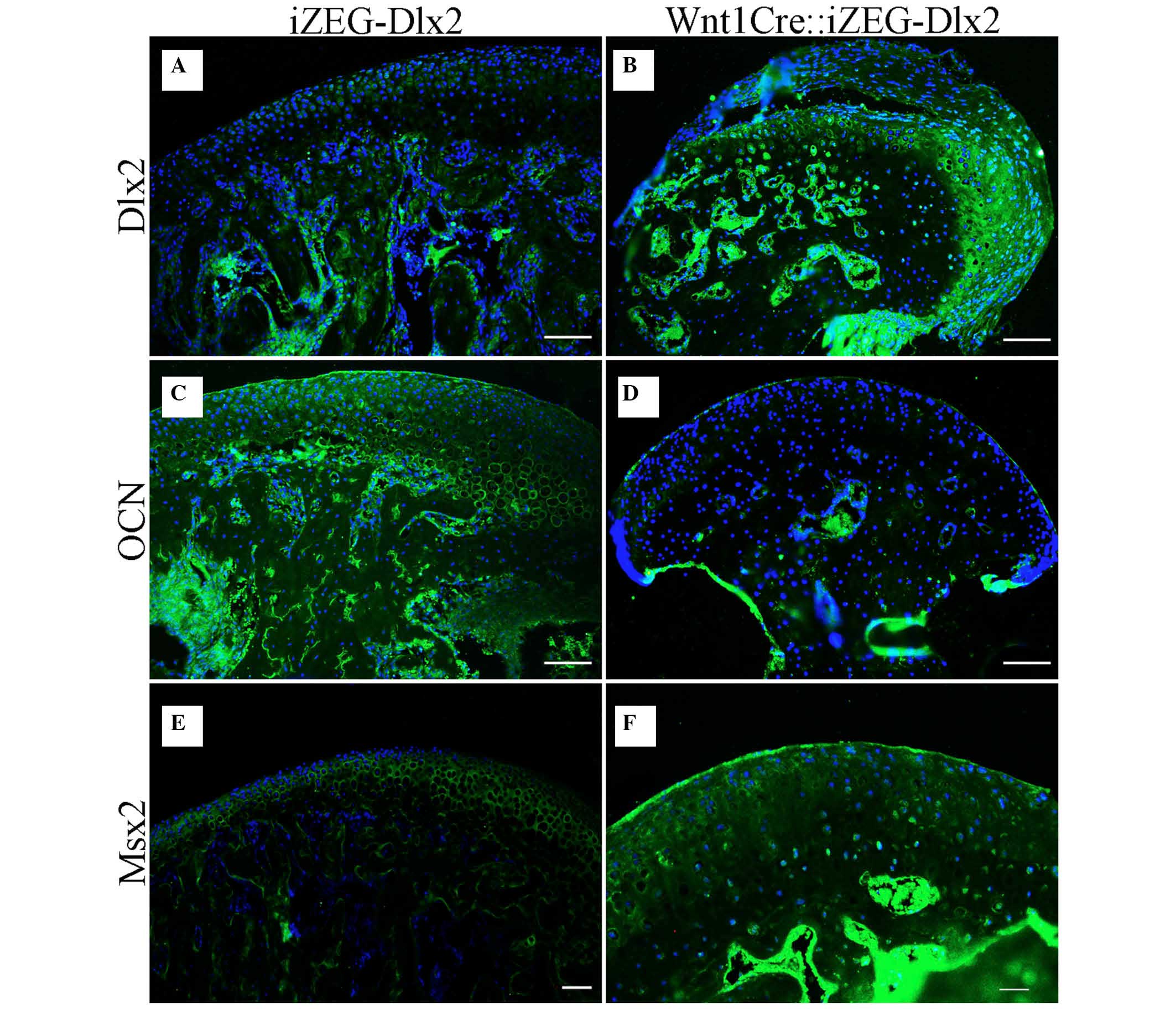|
1
|
Panganiban G and Rubenstein JL:
Developmental functions of the Distal-less/Dlx homeobox genes.
Development. 129:4371–4386. 2002.PubMed/NCBI
|
|
2
|
Depew MJ, Simpson CA, Morasso M and
Rubenstein JL: Reassessing the Dlx code: The genetic regulation of
branchial arch skeletal pattern and development. J Anat.
207:501–561. 2005. View Article : Google Scholar : PubMed/NCBI
|
|
3
|
Thomas BL, Liu JK, Rubenstein JL and
Sharpe PT: Independent regulation of Dlx2 expression in the
epithelium and mesenchyme of the first branchial arch. Development.
127:217–224. 2000.
|
|
4
|
Qiu M, Bulfone A, Martinez S, Meneses JJ,
Shimamura K, Pedersen RA and Rubenstein JL: Null mutation of Dlx-2
results in abnormal morphogenesis of proximal first and second
branchial arch derivatives and abnormal differentiation in the
forebrain. Genes Dev. 9:2523–2538. 1995. View Article : Google Scholar : PubMed/NCBI
|
|
5
|
Qiu M, Bulfone A, Ghattas I, Meneses JJ,
Christensen L, Sharpe PT, Presley R, Pedersen RA and Rubenstein JL:
Role of the Dlx homeobox genes in proximodistal patterning of the
branchial arches: Mutations of Dlx-1, Dlx-2, and Dlx-1 and -2 alter
morphogenesis of proximal skeletal and soft tissue structures
derived from the first and second arches. Dev Biol. 185:165–184.
1997. View Article : Google Scholar : PubMed/NCBI
|
|
6
|
Jeong J, Li X, McEvilly RJ, Rosenfeld MG,
Lufkin T and Rubenstein JL: Dlx genes pattern mammalian jaw
primordium by regulating both lower jaw-specific and upper
jaw-specific genetic programs. Development. 135:2905–2916. 2008.
View Article : Google Scholar : PubMed/NCBI
|
|
7
|
Beverdam A, Merlo GR, Paleari L, Mantero
S, Genova F, Barbieri O, Janvier P and Levi G: Jaw transformation
with gain of symmetry after Dlx5/Dlx6 inactivation: Mirror of the
past? Genesis. 34:221–227. 2002. View Article : Google Scholar : PubMed/NCBI
|
|
8
|
Depew MJ, Lufkin T and Rubenstein JL:
Specification of jaw subdivisions by Dlx genes. Science.
298:381–385. 2002. View Article : Google Scholar : PubMed/NCBI
|
|
9
|
McKeown SJ, Newgreen DF and Farlie PG:
Dlx2 over-expression regulates cell adhesion and mesenchymal
condensation in ecto-mesenchyme. Dev Biol. 281:22–37. 2005.
View Article : Google Scholar : PubMed/NCBI
|
|
10
|
Gordon CT, Brinas IM, Rodda FA, Bendall AJ
and Farlie PG: Role of Dlx genes in craniofacial morphogenesis:
Dlx2 influences skeletal patterning by inducing ectomesenchymal
aggregation in ovo. Evol Dev. 12:459–473. 2010. View Article : Google Scholar : PubMed/NCBI
|
|
11
|
Dai J, Kuang Y, Fang B, Gong H, Lu S, Mou
Z, Sun H, Dong Y, Lu J, Zhang W, et al: The effect of
overexpression of Dlx2 on the migration, proliferation and
osteogenic differentiation of cranial neural crest stem cells.
Biomaterials. 34:1898–1910. 2013. View Article : Google Scholar
|
|
12
|
Shibukawa Y, Young B, Wu C, Yamada S, Long
F, Pacifici M and Koyama E: Temporomandibular joint formation and
condyle growth require Indian hedgehog signaling. Dev Dyn.
236:426–434. 2007. View Article : Google Scholar
|
|
13
|
Michikami I, Fukushi T, Honma S, Yoshioka
S, Itoh S, Muragaki Y, Kurisu K, Ooshima T, Wakisaka S and Abe M:
Trps1 is necessary for normal temporomandibular joint development.
Cell Tissue Res. 348:131–140. 2012. View Article : Google Scholar : PubMed/NCBI
|
|
14
|
Oka K, Oka S, Sasaki T, Ito Y, Bringas P
Jr, Nonaka K and Chai Y: The role of TGF-beta signaling in
regulating chondrogenesis and osteogenesis during mandibular
development. Dev Biol. 303:391–404. 2007. View Article : Google Scholar : PubMed/NCBI
|
|
15
|
Owtad P, Park JH, Shen G, Potres Z and
Darendeliler MA: The biology of TMJ growth modification: A review.
J Dent Res. 92:315–321. 2013. View Article : Google Scholar : PubMed/NCBI
|
|
16
|
Dai J, Wang J, Lu J, Zou D, Sun H, Dong Y,
Yu H, Zhang L, Yang T, Zhang X, et al: The effect of co-culturing
costal chondrocytes and dental pulp stem cells combined with
exogenous FGF9 protein on chondrogenesis and ossification in
engineered cartilage. Biomaterials. 33:7699–7711. 2012. View Article : Google Scholar : PubMed/NCBI
|
|
17
|
Kinumatsu T, Shibukawa Y, Yasuda T,
Nagayama M, Yamada S, Serra R, Pacifici M and Koyama E: TMJ
development and growth require primary cilia function. J Dent Res.
90:988–994. 2011. View Article : Google Scholar : PubMed/NCBI
|
|
18
|
Ochiai T, Shibukawa Y, Nagayama M, Mundy
C, Yasuda T, Okabe T, Shimono K, Kanyama M, Hasegawa H, Maeda Y, et
al: Indian hedgehog roles in post-natal TMJ development and
organization. J Dent Res. 89:349–354. 2010. View Article : Google Scholar : PubMed/NCBI
|
|
19
|
Alappat S, Zhang ZY and Chen YP: Msx
homeobox gene family and craniofacial development. Cell Res.
13:429–442. 2003. View Article : Google Scholar
|
|
20
|
Diamond E, Amen M, Hu Q, Espinoza HM and
Amendt BA: Functional interactions between Dlx2 and lymphoid
enhancer factor regulate Msx2. Nucleic Acids Res. 34:5951–5965.
2006. View Article : Google Scholar : PubMed/NCBI
|
|
21
|
Iwata J, Hacia JG, Suzuki A, Sanchez-Lara
PA, Urata M and Chai Y: Modulation of noncanonical TGF-β signaling
prevents cleft palate in Tgfbr2 mutant mice. J Clin Invest.
122:873–885. 2012. View
Article : Google Scholar : PubMed/NCBI
|
|
22
|
Wang XD, Kou XX, He DQ, Zeng MM, Meng Z,
Bi RY, Liu Y, Zhang JN, Gan YH and Zhou YH: Progression of
cartilage degradation, bone resorption and pain in rat
temporomandibular joint osteoarthritis induced by injection of
iodoacetate. PLoS One. 7:e450362012. View Article : Google Scholar : PubMed/NCBI
|
|
23
|
Embree M, Ono M, Kilts T, Walker D,
Langguth J, Mao J, Bi Y, Barth JL and Young M: Role of subchondral
bone during early-stage experimental TMJ osteoarthritis. J Dent
Res. 90:1331–1338. 2011. View Article : Google Scholar : PubMed/NCBI
|
|
24
|
Jiao K, Zhang M, Niu L, Yu S, Zhen G, Xian
L, Yu B, Yang K, Liu P, Cao X and Wang M: Overexpressed TGF-β in
subchondral bone leads to mandibular condyle degradation. J Dent
Res. 93:140–147. 2014. View Article : Google Scholar
|














